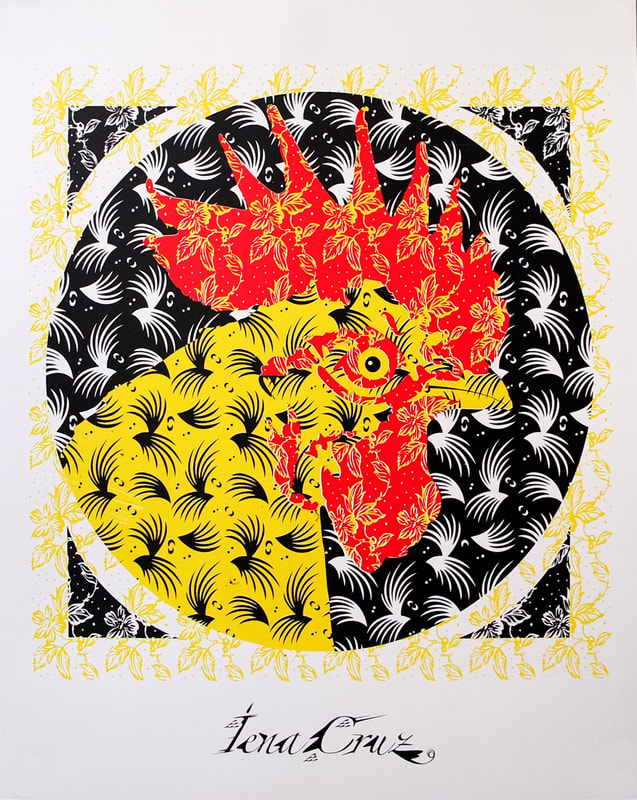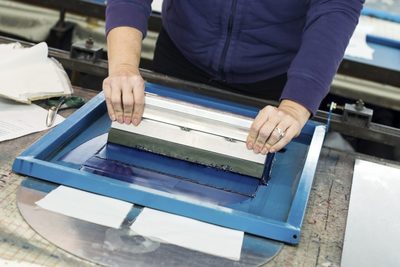|
Interview by Ellie Downey with Federico Massa a.k.a iena Cruz
What brought you to Gowanus Print Lab? I wanted to create samples of my own patterns and then later to produce wallpaper patterns and textiles. How has your experience been at GPL? I have been here for six weeks. It has been a wonderful experience for me. I took the Screen Printing 101 class but I mostly worked in the studio outside of class time. Sean and Rob the teachers were always nearby to help. In particular it has been really productive working by myself and always having somebody around to help me if I needed. I’ve been experimenting more, experimenting with repetition mostly. I have learned all of the pre-printing methods both practically and digitally – for example, the photoshop and illustrator skills needed to print on acetate for screen printing. Throughout the six week 101 class I have been very focused and i’m happy to say, I never messed up on prints. I also got to learn and experiment with different kinds of inks and pigments. Can you introduce us to your artwork and printing style? I started out my practice as a Graffiti artist and street artist. I worked in an art factory with 15 different artists in Milan called “The Bag Art Factory”, which was made up of sculptors, painters and set designers, carrying out exhibitions and projects in Milan, Italy. In the last few years my work focused on climate issues and global warming with depictions of animals. I want to give a voice to animals with my work, in particular endangered species that have to pay the price of human error. I don’t have a printing style as of yet I think – but I am interested in creating patterns and working with repetitions. My painting style is a mix of both the graphic and pictorial. It’s very colorful with sharp lines. In printmaking I had to avoid using a lot of colors. I had to be more selective with my color choices which led me to adopting a more graphic approach. It was challenging to change my painting style into 3-4 colors and I had to come up with other ideas to reduce colors. During my time at GPL I tried CYMK printing. It was challenging and although I got a good result, I couldn’t exactly match the color of my original design. I found the process requires a lot of time and experience. It is really important to make sure everything is registered and I found this method very similar to doing stencils. I would like to try it again soon now that I know the basics, and the amount of time it will take for projects based on my experience. Tell us about the projects that you completed during your time at GPL! I Worked a lot on my project of creating patterns, where I created samples of repeatable patterns with different inks. I created 10-13 different samples which I will show to various fabric and wallpaper producers. I then completed different versions of my design. I am happy to say that my mission is completed! I did not find a difference between printing a pattern style or real design – I was always using three or four colors as I stuck to the same method throughout my experimentation. I learned how to create my own color by mixing pigments and bases and when I started making my own colors in this way the process became really fun. Do you have any upcoming exhibitions/shows coming up that we should know about? Yes! I am going to Japan very soon where I have a show in Tokyo. Below is more information: It was so great chatting with you about your practice Federico! To find out more you can visit Federico’s website, instagram and facebook pages here, and you can contact him by e-mail at [email protected]. iena Cruz will also be one of the artists participating in the upcoming show at GPL on Saturday, May 20th: ALLERGY SEASON x GPL POP UP SHOW. More details to follow!! We hope to see you all there!
1 Comment
Cleaning your screen properly can make the difference between your screen lasting 15 years and your screen lasting two months. Just in case you’ve ever stared at the power washer in utter frustration for not doing its job, check yourself and follow these simple steps!
Step 1: CLEAN OUT ALL THE INK. Though plastisol ink can stay in the screen for longer (unlike water based ink), it is crucial that all ink gets cleaned off both the screen and the frame. Any ink stuck in the creases or edges of the screen and/or frame will cause problems later. Remember that 5 extra minutes of cleaning, could save you time and money later! Step 2: RECLAIMER. Reclaimer is intended for removing emulsion. However, it needs to sit on the screen for a bit to really do its job. Scrub reclaimer well on both sides and let it sit for a few minutes. Letting the chemical do it’s job should make the job easier, even though you may be spending a minute more of your time. If you do not have a backlit wash out station, simply find a source of light and hold the screen to it to make sure all the contaminates and particles are out of the screen completely. Scrub well on both sides and let the chemical sit for a few minutess Step 3: HAZE. There are different kinds of haze remover. At GPL, we use EnviroHaze, which is not as strong as the industrial stuff, but is much better for the environment and far less toxic. Haze removes the shadows or ghost images on your screen. You want to make sure you are able to see plenty of light through your screen to ensure it will print properly! Once again, scrub well on both sides and let the chemical sit for a few moments. Step 4: DEGREASER. Degreasing your screen is arguably the most important step, since it removes the oil and any leftover chemicals, allowing emulsion to sit properly on your screen. For this step, scrub well on both sides (you don’t have to let it sit). Rinse well, set to dry and your screen will thank you later! NOTE: Also, start with Degreaser for brand new screens. HAPPY SCREEN PRINTING!!!!!! |













 RSS Feed
RSS Feed